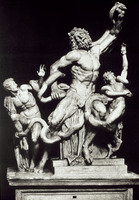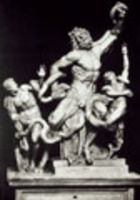| dc.description | Marble sculptural group that represents an episode recounted in Virgil’s Aeneid (II.199–231), in which a sea monster attacks the Trojan priest Laokoon and his two young sons in front of the walls of Troy. The date and provenance of the work (Rome, Vatican, Cortile Belvedere; h. 2.42 m; see Rome, ancient, fig. 59) is disputed. Its identification with the Laokoon by the Rhodian sculptors Hagesandros, polydoros and athenodoros, said by Pliny (Natural History XXXVI.iv.37) to have adorned the Palace of Titus at Rome, has been questioned because Pliny claimed that the latter was made from a single block of marble, while the extant group is made from several. However, stylistic resemblances between the surviving group and the sculptures in the grotto at Sperlonga actually signed by Hagesandros, Polydoros and Athenodoros (see Sperlonga, §2) have caused many scholars to accept it as the Laokoon mentioned by Pliny. They regard it as a work of the 1st century ad in the stylistic tradition of the sculptures of Hellenistic Pergamon (see Pergamon, §3), but perhaps also inspired by statues on Rhodes (see Rhodes, §3(ii)). The sculpture was discovered on 14 January 1506 in a vineyard not far from the basilica of S Maria Maggiore in Rome, and was placed in a niche in the Cortile del Belvedere in the Vatican. In 1797 it was moved to Paris, and later put on display in the Musée Central des Arts until 1815; the following year it was returned to its original setting in the Vatican. When the group was found it lacked the right arm of Laokoon and the right hands of his sons, but during the 1530s Giovanni Angelo Montorsoli replaced the arm in terracotta, although its position is not certain. In a copy of the group by the sculptor Baccio Bandinelli (c. 1520–22; Florence, Uffizi) the arm is bent, as it probably was in antiquity. A terracotta arm extending upwards, perhaps not the one by Montorsoli, remained on the sculpture from the second half of the 16th century until it was moved to Paris. For centuries the Laokoon enjoyed enormous fame, equal to that of the Apollo Belvedere (Rome, Vatican, Mus. Pio-Clementino). It was not only copied by artists from the earliest days of its discovery, but also profoundly influenced the anatomy, poses and mood of their work. | en_US |



